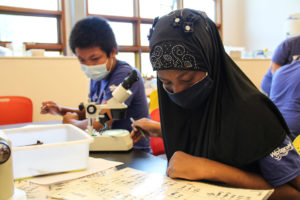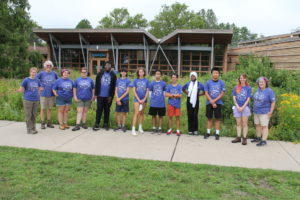 After a simulated volcanic eruption in a grassy field at The Watershed Institute, Tierna Matecha, 18, measured the distance from a “trashcano” to colorful balls scattered on the grass as she and others in the Watershed Academy for High School Students recorded dozens of data points.
After a simulated volcanic eruption in a grassy field at The Watershed Institute, Tierna Matecha, 18, measured the distance from a “trashcano” to colorful balls scattered on the grass as she and others in the Watershed Academy for High School Students recorded dozens of data points.
This summer, five students from the Greater Trenton area have joined others in the academy’s three biweekly offerings – Climate Change, Stream Science, and Clean Water. The five also spent some additional weeks with Watershed staff who connected students with transformative learning experiences, fieldwork for upcoming academy sessions, college prep, and careers in environmental and other sciences.
 “In everything they do, the academy students are learning to think like scientists by forming a hypothesis, collecting data, and finding their results by doing hands-on experiments,” said Pat Heaney, Assistant Education Director at The Watershed Institute. “We follow the claims, evidence, and results approach of a scientific mindset.”
“In everything they do, the academy students are learning to think like scientists by forming a hypothesis, collecting data, and finding their results by doing hands-on experiments,” said Pat Heaney, Assistant Education Director at The Watershed Institute. “We follow the claims, evidence, and results approach of a scientific mindset.”
In the “trashcano” experiment, Princeton University’s Lisa Gallagher, Ph.D., an Education and Outreach Manager at the High Meadows Environmental Institute (HMEI), and her project coordinator, Tara Kelly, guided the students with a dramatic visualization of volcanic eruptions.
Gallagher and Kelly poured about 250 ml of liquid nitrogen into a small plastic bottle that was quickly engulfed by a gaseous cloud. They capped the bottle and dropped it into the “trashcano,” a sturdy trashcan that contained a small waste can submerged in water and surrounded by an assortment of 40 floating plastic balls, which represented volcanic material.
 Seconds later as the pressure mounted, the Academy students and Watershed staff shrieked as the “trashcano” exploded, propelling the balls in many directions.
Seconds later as the pressure mounted, the Academy students and Watershed staff shrieked as the “trashcano” exploded, propelling the balls in many directions.
When it was safe, the academy students measured each ball’s distance from the trashcan, averaged the data for each ball size, and tested their hypothesis of which type would travel farther: the smaller, ping-pong-sized balls or larger baseball-sized balls?
As a precursor to the “trashcano” modeling, the students had imitated volcanic eruptions using Mentos dropped into carbonated soda bottles. They explored variables of shaking and volume to gauge the effect on the soda plume and the distance the mints flew.
 Overall, Tierna said the extra weeks were as much fun as the regular academy sessions. Those weeks were less formal, more intimate, and offered other inventive activities, such as figuring out soil permeability, writing advocacy letters to township officials, and learning about critters in the Watershed Center.
Overall, Tierna said the extra weeks were as much fun as the regular academy sessions. Those weeks were less formal, more intimate, and offered other inventive activities, such as figuring out soil permeability, writing advocacy letters to township officials, and learning about critters in the Watershed Center.
“Before I thought of insects as scary and now I think they are gross and interesting – which is an improvement,” said Tierna, of Hamilton who will attend Smith College in the fall. “I always knew I would be going into the environmental field, and my Watershed experience this summer has reaffirmed my decision.”
 Former Watershed Nature camper Joel Bodon, 14, of Trenton, said he enjoyed both the academy and smaller group activities with Watershed staff during the gap weeks.
Former Watershed Nature camper Joel Bodon, 14, of Trenton, said he enjoyed both the academy and smaller group activities with Watershed staff during the gap weeks.
During those weeks, Joel said they learned about the butterflies, helped remove predators like katydids from the Kate Gorrie Butterfly House, and dyed wool with flowers, bark, and other natural items.
 As a rising sophomore at the Peddie School, he said he enjoyed the Climate Change session with guest speakers and meteorologists who gave them a tour of the weather station on the Watershed Reserve.
As a rising sophomore at the Peddie School, he said he enjoyed the Climate Change session with guest speakers and meteorologists who gave them a tour of the weather station on the Watershed Reserve.
“I really look up to David (A.) Robinson and Bernadette Woods Placky because I would like to be a meteorologist,” he said. “The academy weeks gave us four days to explore these topics more fully.”
He said it was “liberating” to have the extra weeks for hands-on learning activities. “If we didn’t have those in-between weeks, it would be more difficult to become friends with everyone. It was great learning and made me more prepared for the academy sessions.”
 Payton Tharp, 17, of Yardley and a rising senior at Hopewell Valley Central High School, said although she has always had an interest in nature and was a former Watershed camper and counselor-in-training, she previously wasn’t that academically engaged by science.
Payton Tharp, 17, of Yardley and a rising senior at Hopewell Valley Central High School, said although she has always had an interest in nature and was a former Watershed camper and counselor-in-training, she previously wasn’t that academically engaged by science.
“The first Climate Change academy week, I was overwhelmed because there was all this scientific stuff being thrown at me,” she said. “Then it all kind of came together. There were a lot of hands-on experiences that made me feel smart like I didn’t need a big brain to understand.”
She and others in the Stream Science academy session collected bacterial and chemical samples from Beden Brook in Hopewell Borough, devised a scientific question and offered their solutions in a capstone presentation. She also wrote to the Hopewell Mayor about their findings that contribute to degraded water quality in parts of Beden Brook.
 “My group discovered a landscape company that had dumped lawn clippings into one section of the brook,” she said. “We noticed high phosphate, e-coli and nitrate readings from this and other activities.”
“My group discovered a landscape company that had dumped lawn clippings into one section of the brook,” she said. “We noticed high phosphate, e-coli and nitrate readings from this and other activities.”
She said in the gap weeks between academy sessions, “we got to learn more about the Watershed and the natural environment. It was more chill in the smaller groups.”
The students said the hands-on learning in the academies gave them something to do for consecutive weeks in the summer, with engaging and fun activities.




